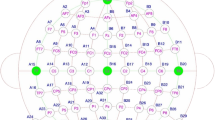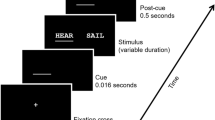Abstract
Orton (1936) observed that dyslexic readers display not only obvious linguistic processing errors, but also diminished lateralized specialization of other cerebral hemispheric functions. To explore his “intergrading” hypothesis, six developmental dyslexics (DDs) and a group of good readers (GRs) were tested on measures of interhemispheric coordination. All subjects (ages 16 to 47) demonstrated normal oculomotor control and visual acuity prior to testing. Subjects were instructed to track three different point-light source patterns, (single stimulus in one hemifield, dual stimuli in one hemifield and a pair of simultaneous, symmetric, bihemifield stimuli [SSBS]), presented in random sequence and arrayed horizontally at ±5, ±10, and ±15 degrees eccentricity. Tested with unihemifield stimuli, all subjects showed normal saccadic latencies and trajectories. In response to SSBS, all GRs showed pronounced directional preference, choosing largely to track one side over the other. DDs showed reduced laterality bias (p<.025). DDs showed significantly longer response latencies to SSBS than to unihemifield stimulation (p<.01) and differed significantly from GRs (p<.05).
Similar content being viewed by others
References
Adler-Grinberg, D. and Stark, L. 1978. Eye movements, scanpaths, and dyslexia.American Journal of Optometry and Physiological Optics 55:567–570.
Bahill, T. A., Clark, M. R., and Stark, L. 1975. The main sequence, a tool for studying human eye movements.Math Bioscience 26:191–204.
Breitmeyer, B. G. 1983. Sensory masking, persistence and enhancement in visual exploration and reading.In K. Rayner, (ed.).Eye Movements in Reading: Perceptual and language processes. New York: Academic Press.
Brown, B., Haegerstrom-Portnoy, G., Adams, A. J., Yingling, C. D., Galin, D., Herron, J., and Marcus, M. 1983a. Predictive eye movements do not discriminate between dyslexic and control children.Neuropsychologia 21:121–128.
Brown, B., Haegerstrom-Portnoy, G., Adams, A. J., Yingling, C. D., Galin, D., Herron, J., and Marcus, M. 1983b. Tracking eye movements are normal in dyslexic children.American Journal of Optometry and Physiological Optics 60:376–383.
Bunt, A. J., Minckler, D. S., and Johanson, G. W. 1977. Demonstration of bilateral projection of the central retina of the monkey with horseradish peroxidase neuronography.Comparative Neurology 171:619–630.
Ciuffreda, K. J., Bahill, A. F., Kenyon, R. V., and Stark, L. 1984. Eye movements during reading: Case reports.American Journal of Optometry and Physiological Optics 53:389–395.
Critchley, M. 1970.The Dyslexic Child. London: William Heinemann Medical Books Limited.
Dalby, J. Y. and Gibson, D. 1981. Functional cerebral lateralization in subtypes of disabled readers.Brain and Language 14:34–48.
De Jong, J. D. and Jones, G. M. 1971. Akinesia, hypokinesia, and bradykinesia in the oculomotor system of patients with Parkinson’s disease.Experimental Neurology 32:58–68.
Denckla, M. B. 1979. Childhood learning disabilities.In K. Heilman and E. Valenstein (eds.).Clinical Neuropsychology.
Doehring, D. G. 1984. Subtyping of reading disorders: Implications for remediation.Annals of Dyslexia 34:205–216.
Drake, W. E. 1968. Clinical and pathological findings in a child with a developmental learning disability.Journal of Learning Disabilities 1:486–502.
Duffy, F. H., Denckla, M. B., Bartels, P. H. and Sandini, G. 1980a. Dyslexia: Regional differences in brain electrical activity by topographic mapping.Annals of Neurology 7:412–420.
Duffy, F. H., Denckla, M. B., Bartels, P. H., Sandini, G. and Kiesslinge, L. S. 1980b. Dyslexia: Automated diagnosis by computerized classification of brain electrical activity.Annals of Neurology 7:421–428.
Elterman, R. D., Abel, L. A., Daroff, R. B., Dell’Osso, L. F. and Bornstein, J. L. 1980. Eye movement patterns in dyslexic children.Journal of Learning Disabilities 13:16–21.
Eskenazi, B. and Diamond, S. P. 1983. Visual Exploration of non-verbal material by dyslexic children.Cortex 19:353–370
Findlay, J. M. 1983. Visual information processing for saccadic eye movements.In A. Hein and M. Jeannerod (eds.).Spatially Oriented Behavior. New York: Springer-Verlag.
Fisher, J. H. 1910. A case study of congenital word-blindness (inability to learn to read).Opthalmological Society 30:216–225.
Galaburda, A. M. and Kemper, T. L. 1979. Cytoarchitectonic abnormalities in developmental dyslexia: A case study.Annals of Neurology 6:94–100.
Galaburda, A. M. 1984. Anatomical asymmetries.In N. Geschwind and A. Galaburda (eds.).Cerebral Dominance: The biological foundations. Cambridge: Harvard University Press.
Gazzaniga, M. S. 1974. Cerebral dominance viewed as a decision system.In S. Dimond and J. Beaumont (eds.).Hemisphere Function in the Human Brain. London: Paul Elek.
Geschwind, N. 1982. Why Orton Was Right.Annals of Dyslexia 32:13–30.
Geschwind, N. and Behan, P. 1982. Left handedness: association with immune disease, migraine and developmental learning disorders.Proceedings of the National Academy of Sciences, U.S.A. 79:5097–5100.
Gross-Glen, K. and Rothenberg, S. 1984. Evidence for deficit in interhemispheric transfer of information in dyslexic boys.International Journal of Neuroscience 24:23–35.
Hallet, P. E. 1978. Primary and secondary saccades to goals defined by instructions.Vision Research 18:1279–1296.
Heller, D. 1979. Eye movements in dyslexic and normal reading children.Zeitschrift fur Psychologie 187:106–115.
Hermann, H. T., Sonnabend, N. L. and Zeevi, Y. Y. 1986. Interhemispheric coordination is compromised in dyslexia.Cortex (in press).
Hermann, K. 1959,Reading Disability. Springfield: Charles C. Thomas.
Hinshelwood, J. 1895. Word Blindness and visual memory.Lancet 2:1564–1570.
Hinshelwood, J. 1900.Letter-, Word- and Mind-Blindness. London: H. K. Lewis.
Hinshelwood, J. 1917.Congenital Word-Blindness. London: H. K. Lewis and Company.
Jones, A., and Stark, L., 1980. Reverse staircase reading eye movements.Supp. Invest. Opthal. and Vision Research.
Jones, A., and Stark, L. 1983. Abnormal patterns of normal eye movements in specific dyslexia.In K. Rayner (ed.).Eye Movements in Reading (Perceptual and Language Processes). New York: Academic Press.
Jones, G. M. and DeJong, J. D. 1971. Dynamic characteristics of saccadic eye movements in Parkinson’s disease.Experimental Neurology 31:17–31.
Kemper, T. L. 1984. Asymmetrical lesions in dyslexia.In N. Geschwind and A. Galaburda (eds.).Cerebral Dominance: The biological foundations. Cambridge: Harvard University Press.
Kenyon, R. V., Becker, J. T., Butters, N. and Hermann, H. T. 1984. Oculomotor functions in Wernicke-Korsakoff’s syndrome: Saccadic eye movements.International Journal of Neurosciences.
Kinsbourne, M. and McMurray, J. 1975. The effect of cerebral dominance on time sharing between speaking and tapping by preschool children.Child Development 46:240–242.
Kinsbourne, M. 1983. Models of learning disability.Topics in Learning and Learning Disabilities 3:1–13.
Kris, C. 1969. Developmental and diagnostic EOG and EEG studies of binocular visual responsiveness and oculomotor control in children and adults with perceptual, reading and learning difficulties.Journal of Electroencephalography and Clinical Neurophysiology 26:633–634.
Kussmaul, A. 1877. Disturbance of Speech.In H. von Ziemssen (ed.).Cyclopedia of the practice of medicine 14. 121, translated by J. A. McCreery. New York: William Wood.
Lahey, B. J., Kupper, D. L., Beggs, V., and Landon, D., 1982. Do learning-disabled children exhibit peripheral deficits in selective attention? An analysis of eye movements during reading.Journal of Child Psychology 10:1–10.
Legein, Ch. P., and Bouma, H. 1982. Reading and opthalmologist. An introduction into the complex phenomenon of ordinary reading as a guideline for analysis and treatment of disabled readers.Documenta Opthalmologica 53:123–157.
Leisman, G., and Schwartz, K. J. 1978a. Aetiological factors in dyslexia: 1. Saccadic eye movement control.Perceptual and Motor Skills 47:403–407.
Leisman, G., and Schwartz, J., 1978b. Aetiological factors in dyslexia: II: Ocular-motor programming.Perceptual and Motor Skills 47:667–672.
Lévy-Schoen, A. 1969. Determination et latence de la response oculomotrice a deux stimuli.L’Annee Psychologuique 69:373–392.
Morgan, W. P. 1896. A case of congenital wordblindness.British Medical Journal 2:1378.
Moscovitch, M., and Klein, D. 1980. Material-specific perceptual interference for visual words and faces: Implications for models of capacity limitations, attention and laterality.Journal of Experimental Psychology (Human Perceptual Performance) 6:590–604.
Newcombe, F., and Marshall, J. C. 1981. On psycholinguistic classifications of the acquired dyslexias.Bulletin of the Orton Society 31:29–45.
Newcombe, F. 1984. Personal communication.
Ober, J. and Ùdden, P. 1985. Personal communication.
Olson, M. E. 1973. Laterality differences in tachistoscopic word recognition in young normal and delayed readers in elementary school.Neuropsychologia 11:343–350.
Olson, R. K., Kliegal, R., and Davidson, B. J. 1983. Dyslexic and normal reader’s eye movements.Experimental Psychology (Human Perception and Performance) 9:816–825.
Orton, S. T. 1925. Word Blindness in school children.Archives of Neurology and Psychiatry 14:581–615.
Orton, S. T. 1936. (Paper presented at the Thomas W. Salmon Memorial Lecture at New York Academy of Medicine.)In S. Orton.Reading, Writing, and Speech Problems in Children. New York: W. W. Norton and Co.
Pavlidis, George Th. 1981. Do eye movements hold the key to dyslexia?Neuropsychologia 19:57–64.
Perlin, H. 1983. Personal communication.
Pirozzolo, F. J., and Rayner, K. 1978. Disorders of oculomotor scanning and graphic orientation in developmental Gerstmann syndrome.Brain and Language 5:119–126.
Pirozzolo, F. J. and Hansch, E. C. 1981. Oculomotor time in dementia reflects degree of cerebral dysfunction.Science 214:349–351.
Poynter, H. L., Schor, C., Haynes, H. M., and Hirsch, J. 1982. Oculomotor functions in reading disability.American Journal of Optometry and Physiological Optics 59:116–127.
Rabinovitch, R. D. 1959. Reading and learning disabilities.In S. Arieti (ed.).American Handbook of Psychiatry. New York: Basic Books.
Rayner, K. 1978. Eye movements in reading and information processing.Psychology Bulletin 85:618–660.
Rayner, K. 1983a. Eye movements, perceptual span and reading disability.Annals of Dyslexia 33:163–173.
Rayner, K. 1983b. The perceptual span and eye movement control during reading eye movements in reading.In K. Rayner (ed.).Eye Movements in Reading: Perceptual and language processes. New York: Academic Press.
Richman, J. E., Walker, A. J., Garzia, R. P. 1983. The impact of automatic digit naming ability on a clinical test of eye movement functioning.Journal of the American Optometric Association 54:617–622.
Stanley, G. 1978. Eye movements in dyslexic children.In G. V. Stanley and K. W. Walsh (eds.).Brain Impairment: Proceedings of the 1977 Brain Impairment Workshop. Melbourne: Neuropsychology Group.
Stanley, G., Smith, G. A. Howell, E. A. 1983. Eye movements and sequential tracking in dyslexic and control children.British Journal of Psychology 74:181–187.
Stein, J. F., and Fowler, S. 1982 Diagnosis of dyslexia by means of a new indicator of eye dominance.British Journal of Opthalmolmology 66:332–336.
Temple, C. M., and Marshall, J. C. 1983. A case study of developmental phonological dyslexia.British Journal of Psychology 74:517–533.
Umilta, C., Rizzolatti, G. Anzola, P., Luppino, G., and Porro, C. 1985. Evidence of interhemispheric transmission in laterality efforts.Neuropsychologia 23:203–213.
Vellutino, F. R. 1979.DYSLEXIA: Theory and Research. Cambridge: The MIT Press.
Wiig, E. H. and Semel, E. M. 1976.Language Disabilities in Children and Adolescents. Columbus: Charles E. Merrill Publishing Co.
Wiig, E. H., and Semel, E. M. 1980.Language Assessment and Intervention for the Learning Disabled. Columbus, Ohio: Charles E. Merrill Publishing Co.
Witelson, S. F. 1977. Developmental dyslexia: Two right hemispheres and none left.Science 195:309–311.
Witelson, S. F. 1985. The brain connection: The corpus callosum is larger in left handers,Science 229:665–667.
Young, L. R. 1962.A Sampled Data Model for Eye Tracking Movements. Sc.D. Dissertation, MIT, Cambridge, Mass.
Zangwill, O. L. and Blakemore, C. 1972. Dyslexia: Reversal of eye movements during reading.Neuropsychologia 10:371–373.
Zeevi, Y. Y., Wetzel, P. and Young L. 1982.Second Interim Technical Progress Report on Visual and Non-visual Factors in Flight Simulation. Contract F336L5-8L-00LL.
Zeevi, Y. Y., Wetzel, P., and Young, L. 1983.Temporal Aspects of Eye Movement When Viewing Multiple Targets. AFHRL-TP-83-6, Nov.
Zeevi, Y. Y. 1984. Unpublished observations on two left handed subjects.
Zeevi, Y. Y., and Hason, A. 1985.Programming of Saccadic Responses to Dual Targets. E.E. Report, Technion-Israel Institute of Technology.
Author information
Authors and Affiliations
Rights and permissions
About this article
Cite this article
Hermann, H.T., Sonnabend, N.L. & Zeevi, Y.Y. Bihemifield visual stimulation reveals reduced lateral bias in dyslexia. Annals of Dyslexia 36, 154–175 (1986). https://doi.org/10.1007/BF02648027
Issue Date:
DOI: https://doi.org/10.1007/BF02648027




